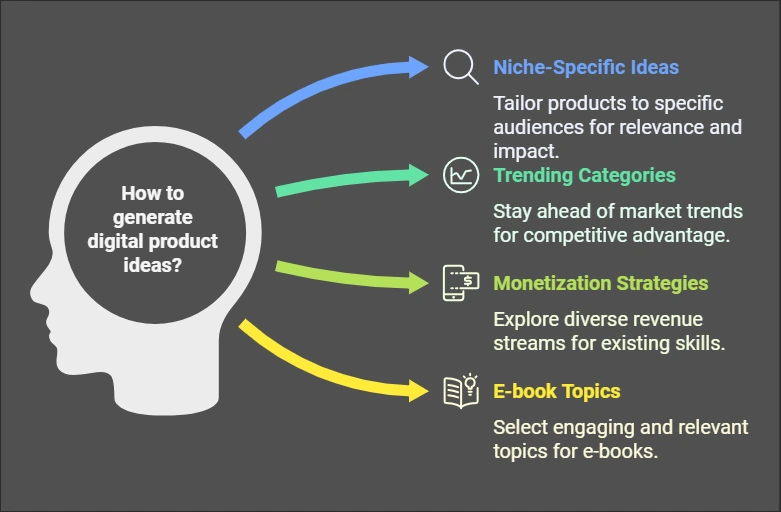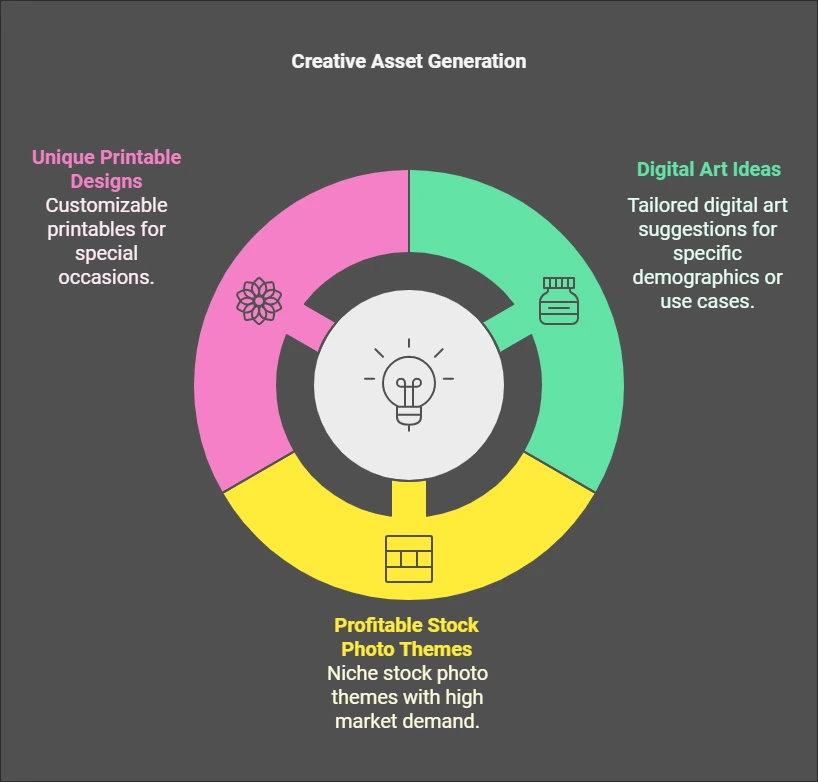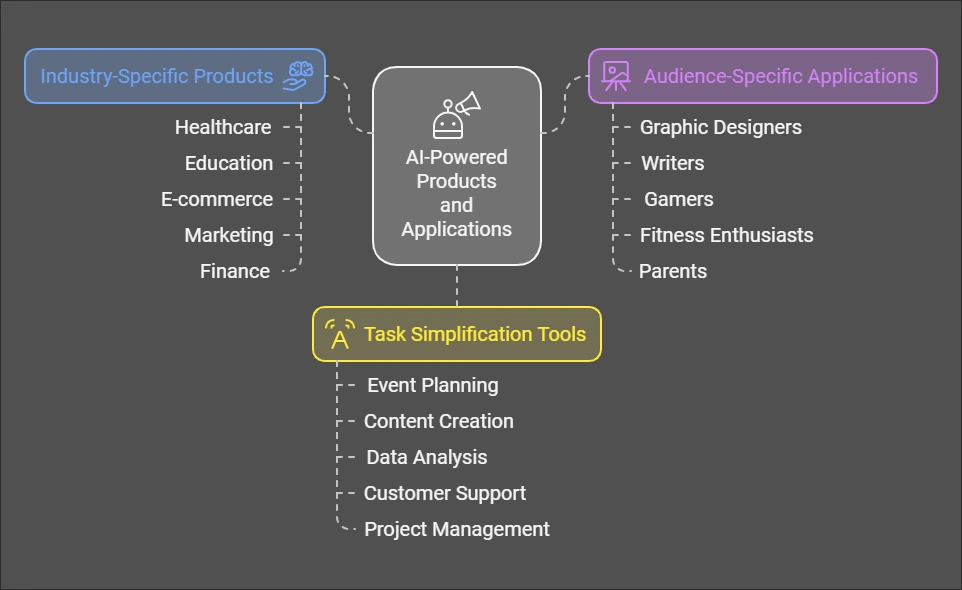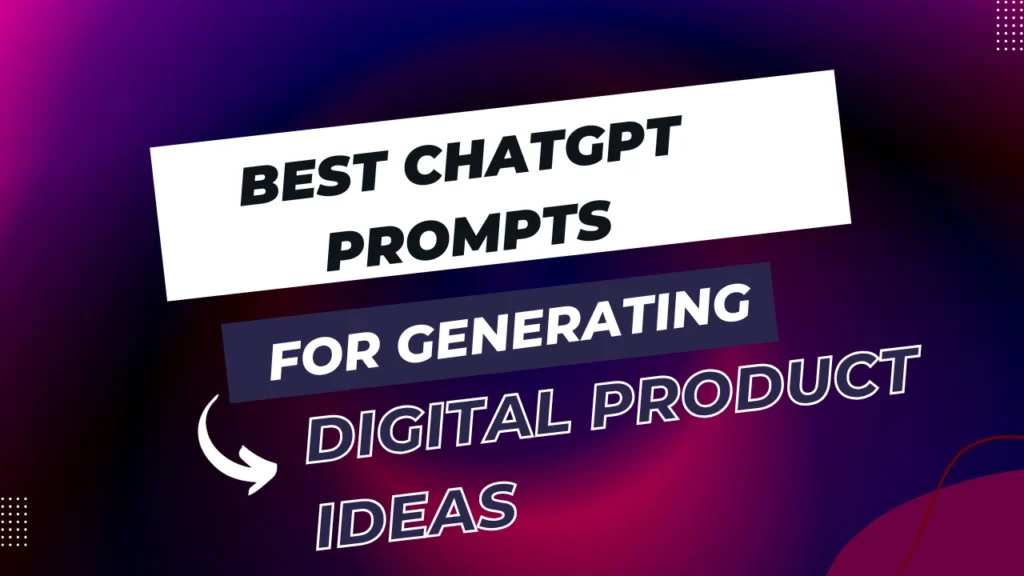Table of Contents
Introduction
Why ChatGPT is a Game-Changer for Digital Entrepreneurs
The digital landscape is evolving at lightning speed, and staying ahead of the curve can feel like chasing shadows. That’s where ChatGPT steps in as a transformative tool for digital entrepreneurs. Whether you’re brainstorming a new product or looking to expand your existing offerings, ChatGPT acts as a virtual idea generator, helping you uncover opportunities you might never have considered. It doesn’t just speed up the creative process—it also brings a fresh, unbiased perspective that can challenge traditional thinking.
The Importance of ChatGPT Prompts in Unlocking Creative Potential
Think of ChatGPT as a sophisticated conversation partner. Its effectiveness, however, depends heavily on the quality of the prompts you provide. A well-crafted prompt is like a carefully phrased question to a mentor—it guides the discussion in a meaningful direction, eliciting responses that are insightful and actionable. Without clear, purposeful prompts, even the most advanced AI can fall short of its potential. That’s why understanding how to frame your requests is crucial for success.
How to Use This Guide for Maximum Results
This guide is designed to be your step-by-step roadmap to extracting the best digital product ideas from ChatGPT. You’ll learn how to craft prompts that generate highly specific and relevant results. From understanding the mechanics of ChatGPT to mastering the art of prompt writing, each section builds on the last, helping you tap into the full potential of AI-powered ideation.
Want to leverage AI to build a profitable online business but don’t know where to start? 🚀 Our beginner-friendly guide walks you through everything you need to know to launch and scale with AI. Don’t miss out—grab your copy of “How to Build an AI-Powered Online Business: A Beginner’s Guide” today! 👉 Get your eBook now!
Understanding ChatGPT Prompts and Digital Product Ideation
What is ChatGPT?
ChatGPT is an advanced AI language model developed by OpenAI, designed to generate human-like text based on the inputs it receives. It has been trained on a massive dataset, allowing it to understand and respond to a wide range of queries. For digital entrepreneurs, it’s more than just a chatbot—it’s a creative collaborator capable of brainstorming ideas, solving problems, and even refining strategies.
How ChatGPT Assists in Ideation
One of ChatGPT’s greatest strengths lies in its ability to think outside the box—without actually “thinking” in the human sense. It uses pattern recognition and contextual understanding to generate diverse ideas across industries. For example, you can ask ChatGPT to suggest innovative product ideas for a specific niche or identify trends that align with your expertise. Its ability to provide tailored responses makes it an invaluable tool in the ideation phase of digital entrepreneurship.
Benefits of Using ChatGPT for Digital Entrepreneurs
- Speed and Efficiency: ChatGPT can generate a plethora of ideas in seconds, saving you hours of brainstorming.
- Cost-Effectiveness: Compared to hiring consultants or conducting market research, using ChatGPT is a budget-friendly alternative.
- Unbiased Suggestions: The AI doesn’t carry preconceived notions, offering a fresh perspective on every query.
- Scalability: Whether you’re a solopreneur or running a team, ChatGPT adapts to your needs, delivering results at scale.
Crafting the Perfect ChatGPT Prompt
Anatomy of a High-Impact Prompt
A high-quality prompt is specific, clear, and goal-oriented. Instead of asking vague questions like, “What’s a good idea for a product?” try something like, “Can you suggest five unique digital product ideas for educators that focus on time-saving tools?” Specificity ensures ChatGPT understands the context and delivers actionable responses.
Want to unlock the power of AI and start a profitable passive income stream? 🚀 Get 15,000+ Advanced ChatGPT Prompts with Resell Rights in this exclusive PLR Bundle—perfect for marketers, entrepreneurs, and content creators! Don’t miss this opportunity to profit from AI! 👉 Grab your bundle now!
Do’s and Don’ts for Writing Effective Prompts
- Do:
- Be clear and concise in your requests.
- Provide context, such as target audience or niche.
- Experiment with variations to refine results.
- Don’t:
- Use overly broad or generic language.
- Expect a perfect response on the first try.
- Overload the prompt with unnecessary details.
Examples of Weak vs. Strong Prompts
- Weak Prompt: “What’s a good digital product idea?”
- This is too vague and lacks context.
- Strong Prompt: “What are three innovative digital product ideas for fitness enthusiasts focusing on home workouts?”
- This is specific, goal-oriented, and provides clear parameters for ChatGPT to work with.
By understanding these principles and examples, you’ll be well-equipped to craft prompts that unlock ChatGPT’s full potential, helping you generate winning digital product ideas with ease.
ChatGPT Prompts for Exploring General Digital Product Ideas

“Suggest five unique digital product ideas in [specific niche]”
This prompt is your go-to for brainstorming niche-specific product ideas. By specifying the niche, such as “freelance writers” or “eco-conscious travelers,” you guide ChatGPT to focus on relevant solutions. For example:
- A mobile app for eco-conscious travel planning.
- A toolkit for freelance writers to pitch clients effectively.
- A budgeting template specifically designed for gig workers.
- A subscription service providing weekly eco-friendly living tips.
- A virtual event guide for travelers focused on sustainable destinations.
The more precise your niche, the more tailored the suggestions will be, enabling you to find standout ideas.
“What are trending digital product categories for 2025?”
This prompt helps you tap into future trends by leveraging ChatGPT’s ability to analyze patterns and predict evolving markets. Categories might include:
- AI-powered personal assistants for niche professions.
- Online courses focusing on blockchain and decentralized finance (DeFi).
- Wellness apps that integrate mental health and fitness tracking.
- Augmented reality (AR) tools for e-commerce.
- Digital templates for remote team collaboration.
Staying ahead of trends gives you a competitive edge in a rapidly changing digital world.
“List innovative ways to monetize [specific skill or topic]”
This prompt is ideal for exploring monetization strategies. For instance, if your skill is “graphic design,” ChatGPT might suggest:
- Selling ready-made logo templates.
- Offering one-on-one design consultations via video calls.
- Creating a course on mastering Adobe Illustrator.
- Designing and selling merchandise with your custom artwork.
- Offering a subscription to exclusive design resources.
By focusing on a specific skill, you can uncover a diverse range of revenue streams.
ChatGPT Prompts for E-books and Online Courses
“What are the top 10 e-book topics in [industry]?”
E-books are a versatile and profitable digital product, but choosing the right topic is key. For a niche like “personal finance,” ChatGPT might suggest:
- How to Build an Emergency Fund on a Tight Budget.
- The Beginner’s Guide to Cryptocurrency.
- Financial Planning for Millennials.
- Debt-Free Living: Strategies That Work.
- Passive Income Ideas You Can Start Today.
Targeting relevant and trending topics ensures your e-book resonates with the audience.
“Outline an online course about [topic] that targets [audience]”
This ChatGPT prompt helps you design a structured and appealing online course. For example, a course on “Freelance Writing for Beginners” targeting aspiring writers could include:
- Understanding the Freelance Market.
- Building a Portfolio from Scratch.
- Crafting Winning Pitches.
- Navigating Contracts and Payments.
- Scaling Your Freelance Business.
With a clear outline, you can create a course that offers actionable value to your audience.
“What skills can be taught effectively online for beginners?”
This prompt reveals opportunities to teach foundational skills. Suggestions might include:
- Basic coding with Python or JavaScript.
- Introductory graphic design with Canva.
- Social media marketing fundamentals.
- Entry-level photography and photo editing.
- Public speaking skills using online practice tools.
These beginner-friendly topics cater to a broad audience looking to upskill.
ChatGPT Prompts for Digital Templates and Tools
“What kinds of templates are most sought after by [target audience]?”
Templates save time and effort, making them highly appealing. For small business owners, ChatGPT might suggest:
- Invoice templates with customizable branding.
- Social media post templates for Instagram and Facebook.
- Business plan templates for startups.
- Meeting agenda templates for team collaboration.
- Budget tracking spreadsheets tailored to entrepreneurs.
Templates that address common pain points are likely to be in demand.
“Generate ideas for productivity tools for [specific profession]”
Productivity tools cater to professionals who value efficiency. For example, teachers might appreciate:
- A lesson-planning app with drag-and-drop features.
- A student progress tracker with visual dashboards.
- A customizable grade book spreadsheet.
- A digital flashcard generator for classroom use.
- An app that schedules parent-teacher meetings seamlessly.
Profession-specific tools like these meet niche needs effectively.
“What unique spreadsheet templates could help [specific user group]?”
Spreadsheets remain a powerful tool for managing data. ChatGPT might suggest for freelancers:
- Time-tracking sheets to calculate billable hours.
- Income and expense trackers with visual summaries.
- Client project management spreadsheets.
- Proposal templates with built-in cost estimation formulas.
- Marketing campaign trackers to monitor ROI.
Offering specialized spreadsheet templates can attract a dedicated user base while solving everyday challenges.
By leveraging these prompts effectively, you can discover endless opportunities to create, refine, and monetize digital products tailored to your audience’s needs.
Prompts for Creative Assets and Art

“Suggest digital art ideas for [specific demographic or use case]”
Digital art is a versatile product that appeals to a wide range of demographics. Using this prompt, you can tailor ideas to a specific audience. For instance, for “young professionals decorating small apartments,” ChatGPT might suggest:
- Minimalist abstract designs in muted tones.
- Motivational typography art with modern fonts.
- Cityscape illustrations of popular urban centers.
- Nature-themed art prints with calming aesthetics.
- Customizable digital art that allows users to add personal quotes or photos.
By focusing on the demographic or use case, you can create digital assets that resonate deeply with your audience.
“What are profitable stock photo themes?”
Stock photos are in high demand, especially when they address niche themes. ChatGPT can suggest ideas such as:
- Diversity and inclusion in the workplace.
- Remote work setups and home office aesthetics.
- Sustainable living and eco-friendly practices.
- Modern family dynamics, such as multigenerational households.
- Wellness-focused themes, including yoga, meditation, and healthy eating.
These trending themes reflect current societal interests, making them more likely to sell.
“Generate concepts for unique printable designs for [occasion]”
Printables are perfect for occasions and celebrations, offering a creative and practical solution. For a wedding-focused audience, ChatGPT might suggest:
- Customizable wedding invitations with floral motifs.
- Save-the-date cards with elegant minimalist designs.
- Printable seating charts and table numbers.
- Wedding planning checklists and budget trackers.
- Guestbook pages with unique prompts for heartfelt messages.
Creating printables for specific occasions adds a personal touch that customers love.
Prompts for Apps and Software Solutions
“What are unsolved problems in [industry] that an app can address?”
Every industry has its pain points, and this prompt helps identify areas where innovation is needed. For instance, in the healthcare industry, ChatGPT might suggest:
- An app to simplify appointment scheduling for patients and clinics.
- A medication reminder app with alerts for dosages.
- A mental health support app that offers daily mindfulness exercises.
- A secure communication platform for doctors and patients.
- A fitness tracker that integrates with medical devices for holistic health monitoring.
Focusing on unsolved problems ensures your app addresses genuine needs.
“Suggest features for a user-friendly [type of app]”
When building an app, its usability often determines its success. For example, a user-friendly budgeting app could include:
- Intuitive dashboards with visual spending summaries.
- Automatic categorization of expenses.
- Personalized saving goals with progress tracking.
- Alerts for upcoming bills or low balances.
- A “what-if” scenario tool to forecast financial decisions.
Tailoring features to enhance user experience helps your app stand out in a crowded market.
“What are innovative software ideas for [specific audience]?”
This prompt allows you to explore niche markets and cater directly to specific user groups. For small business owners, ChatGPT might suggest:
- A CRM tool that automates customer follow-ups.
- An invoicing platform with integrated payment tracking.
- A task management tool that prioritizes deadlines visually.
- A business name generator with domain availability checks.
- A social media content scheduler with AI-generated captions.
Focusing on specific audiences ensures your software delivers targeted solutions.
Prompts for Subscription Services
“What niche topics could sustain a subscription-based digital product?”
Subscription-based models thrive on consistent value delivery. ChatGPT might suggest topics like:
- A monthly toolkit for mastering productivity hacks.
- Exclusive templates and resources for wedding planners.
- A subscription box for aspiring writers with prompts and exercises.
- Monthly deep dives into emerging industry trends.
- Access to a library of digital art for creative professionals.
Choosing niche topics ensures a loyal subscriber base with ongoing interest.
“Generate ideas for exclusive membership content for [target audience]”
Memberships thrive on exclusive value. For an audience of aspiring photographers, ChatGPT might propose:
- Access to premium tutorials on advanced editing techniques.
- A members-only stock photo marketplace to sell and share work.
- Monthly webinars with industry professionals.
- Early access to new photography gear reviews.
- Personalized feedback sessions on photo submissions.
Exclusive content builds a sense of community and justifies ongoing subscriptions.
“What recurring problems could a subscription service solve in [field]?”
Recurring problems present ideal opportunities for subscription-based solutions. In the fitness field, for instance, ChatGPT might suggest:
- Weekly personalized workout plans with video demonstrations.
- Meal prep guides tailored to dietary preferences.
- Progress tracking tools with monthly fitness assessments.
- Motivational content, like daily fitness challenges.
- Access to a supportive online community for accountability.
By addressing recurring pain points, subscription services provide long-term value that keeps customers engaged.
With these prompts, you can unlock endless opportunities to create and refine digital products tailored to your audience’s specific needs and preferences.
Prompts for AI-Powered Products

“Suggest AI-driven digital products for [specific industry]”
Artificial intelligence has the power to revolutionize industries by automating processes and offering innovative solutions. Here are some ideas ChatGPT might generate for specific industries:
- Healthcare: AI-powered patient diagnostics tools, symptom trackers, or appointment optimization systems.
- Education: Personalized AI tutors that adapt to students’ learning speeds and styles.
- E-commerce: AI tools for real-time product recommendations or virtual try-on experiences.
- Marketing: AI-driven ad copy generators or predictive analytics for campaign optimization.
- Finance: AI-based budgeting assistants or fraud detection systems.
By focusing on industry-specific challenges, these products can deliver highly tailored and impactful solutions.
“What creative applications of AI could appeal to [specific audience]?”
Creativity and AI often go hand in hand, making it possible to engage niche audiences effectively. For example:
- Graphic Designers: AI tools that generate customizable design templates or palette suggestions.
- Writers: AI-powered content assistants for brainstorming ideas or editing.
- Gamers: AI-driven NPC (non-playable character) generators that enhance game experiences.
- Fitness Enthusiasts: AI tools for personalized workout plans and real-time performance tracking.
- Parents: AI story generators that craft bedtime tales based on children’s preferences.
Tapping into audience-specific needs ensures the AI-powered products are both practical and appealing.
“Generate ideas for AI tools that simplify [specific task]”
AI excels at making complex tasks easier. Use this prompt to explore ideas like:
- Event Planning: AI that generates to-do lists, schedules, and vendor recommendations.
- Content Creation: AI for automating social media post generation and scheduling.
- Data Analysis: Tools that summarize key insights from large datasets in seconds.
- Customer Support: Chatbots with advanced natural language processing for seamless user interactions.
- Project Management: AI assistants that prioritize tasks and flag deadlines automatically.
These tools not only save time but also enhance efficiency across a variety of tasks.
Advanced Tips for Using ChatGPT for Ideation
How to Refine and Build Upon Generated Ideas
When ChatGPT offers a base idea, you can refine it by asking follow-up questions. For example:
- Start with, “What AI tools could simplify inventory management?”
- Refine with, “What features would make these tools scalable for small businesses?”
By continuously narrowing or expanding the scope, you can evolve a basic concept into a fully-fledged product idea.
Integrating User Feedback into Your Ideation Process
Customer feedback is a goldmine for validating and refining ideas. Once you generate ideas with ChatGPT, test them by:
- Conducting surveys to gauge interest.
- Hosting focus groups to gather opinions.
- Analyzing pain points mentioned in customer reviews or forums.
This ensures your final product aligns with real-world needs and expectations.
Iterating Prompts to Unlock Deeper Insights
ChatGPT works best when prompts are iterative. For example:
- Start broad: “Suggest popular digital products for freelancers.”
- Narrow down: “What tools could help freelance writers manage projects?”
- Get specific: “Generate features for a freelance writing project tracker.”
Each iteration digs deeper, unlocking insights you may not have considered initially.
Common Challenges and Solutions
When ChatGPT Outputs Generic or Repetitive Ideas
If the suggestions feel uninspired, try these tactics:
- Reframe the prompt with more specific details, like audience demographics or industry trends.
- Use comparative prompts, such as “How do these ideas compare to existing products in [industry]?”
- Experiment with creative constraints, e.g., “Suggest AI-powered tools that cost under $100 to develop.”
How to Navigate Niche-Specific Constraints
Certain niches may have unique limitations, such as regulatory hurdles or technical requirements. Overcome these by:
- Asking ChatGPT about legal considerations: “What are the compliance requirements for [niche] digital products?”
- Exploring workarounds: “How can [specific limitation] be addressed creatively?”
This ensures your product ideas remain practical and achievable.
Avoiding Overwhelm When Evaluating Numerous Suggestions
ChatGPT can generate a flood of ideas, so it’s important to prioritize effectively:
- Categorize suggestions based on feasibility, profitability, and alignment with your goals.
- Use tools like SWOT analysis to evaluate the strengths and weaknesses of each idea.
- Start small: Test a minimum viable product (MVP) before committing significant resources.
Summary
Key Takeaways from Using ChatGPT for Idea Generation
- ChatGPT is an invaluable tool for brainstorming digital product ideas, from e-books to AI-driven solutions.
- Specific, well-crafted prompts lead to actionable and innovative suggestions.
- Iterating prompts and incorporating user feedback can refine ideas into market-ready products.
How ChatGPT Can Revolutionize Your Digital Product Strategy
By leveraging ChatGPT, you can identify untapped opportunities, streamline the ideation process, and create products that resonate with your target audience. Whether you’re a seasoned entrepreneur or just starting out, this AI tool can unlock new levels of creativity and efficiency.
FAQs
What is the best way to write a prompt for digital product ideas?
Be clear, specific, and include relevant details about your audience or industry. For example, instead of asking for “digital product ideas,” specify the niche, task, or demographic you’re targeting.
Can ChatGPT generate profitable ideas on its own?
While ChatGPT offers valuable suggestions, profitability depends on market research, execution, and demand validation. Use its ideas as a starting point.
How do I evaluate which ChatGPT-generated idea to pursue?
Prioritize ideas based on feasibility, market demand, and alignment with your skills or resources. Testing through MVPs and user feedback is crucial.
What industries benefit most from ChatGPT-driven ideation?
Industries like e-commerce, education, creative services, and SaaS see significant benefits due to their dynamic nature and demand for innovation.
Are there limitations to using ChatGPT for idea generation?
Yes, ChatGPT relies on the quality of input and cannot independently validate ideas. Always pair its outputs with market research and human judgment for the best results.

